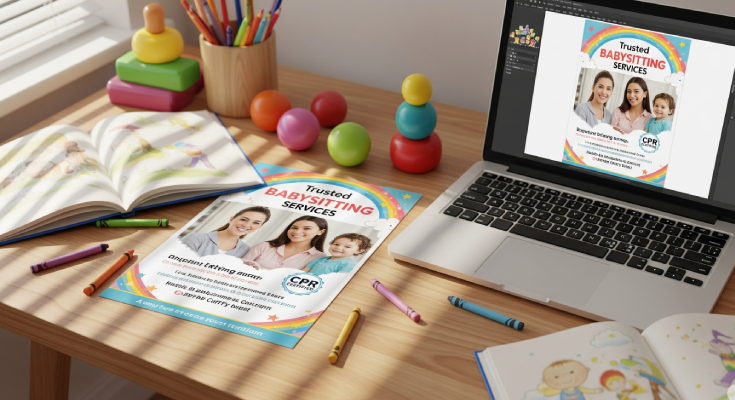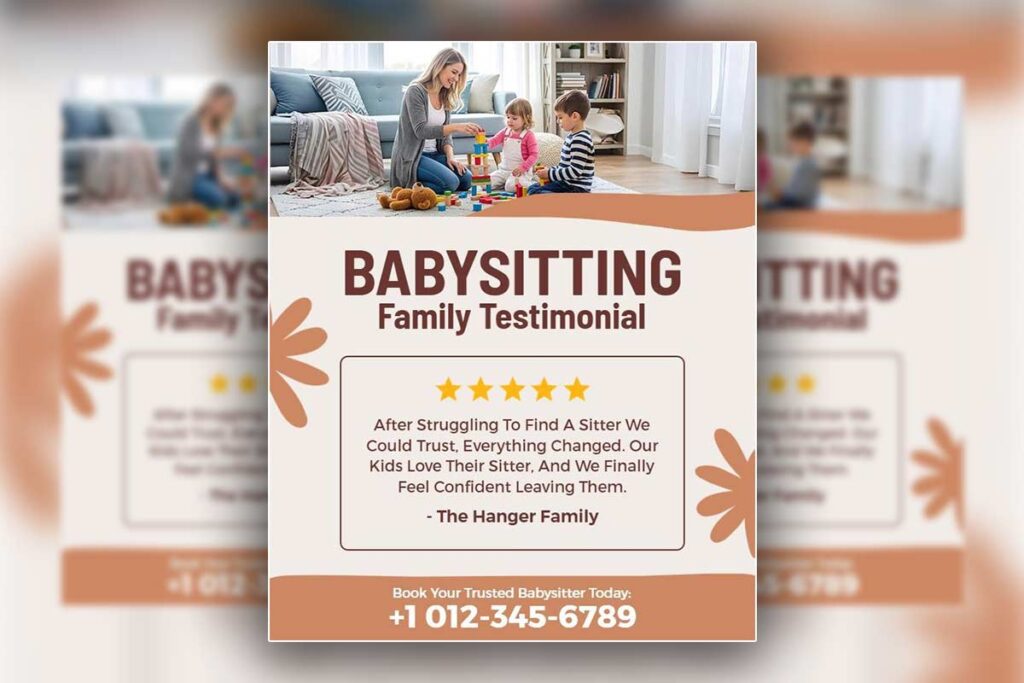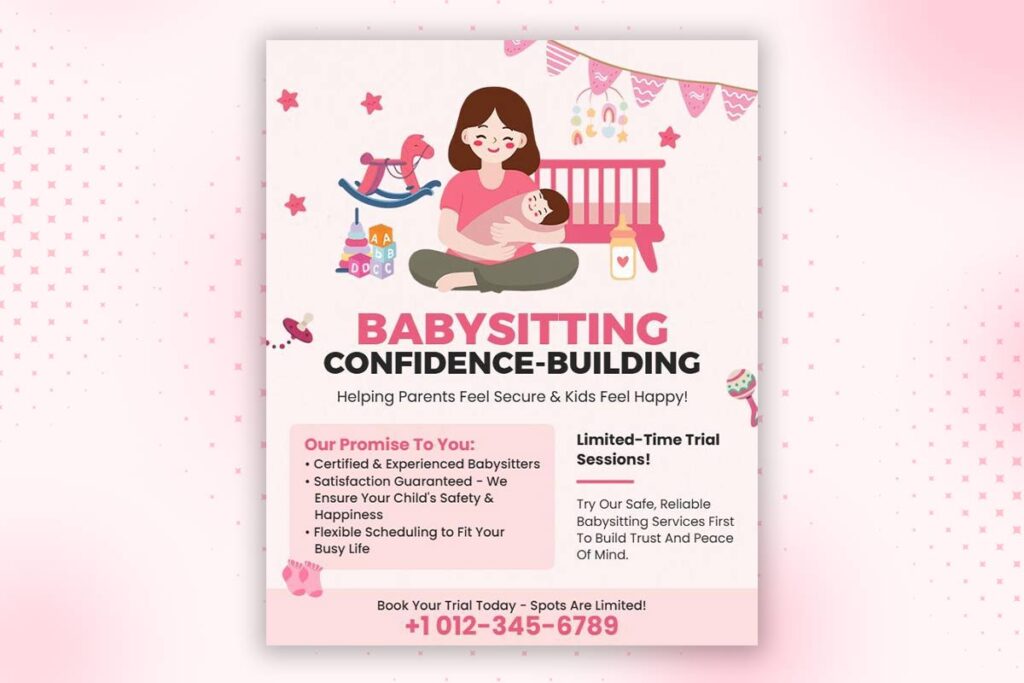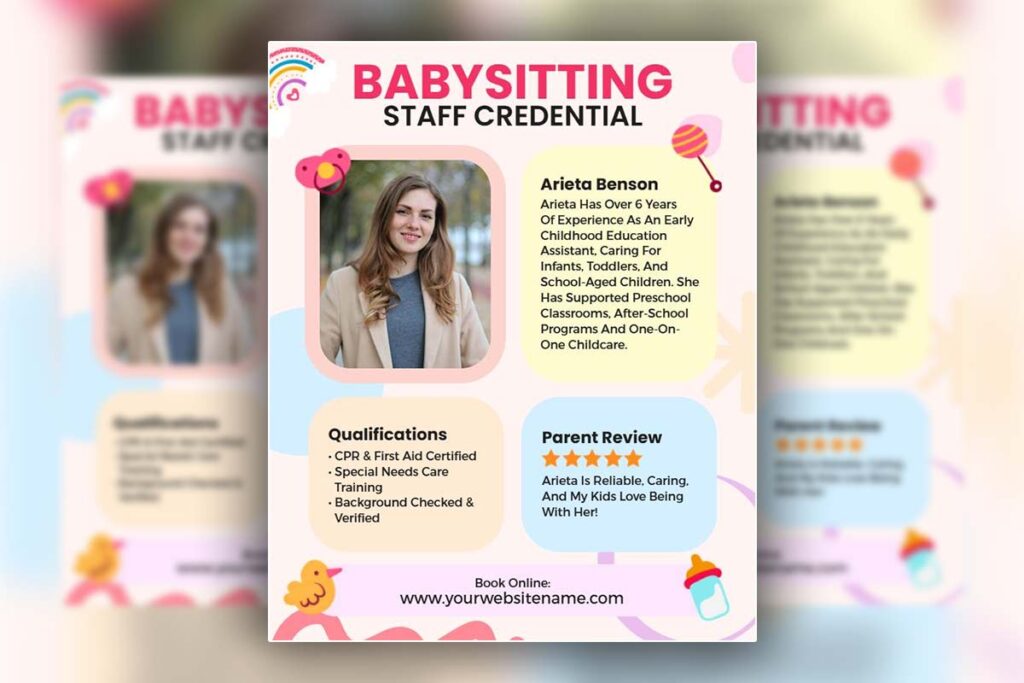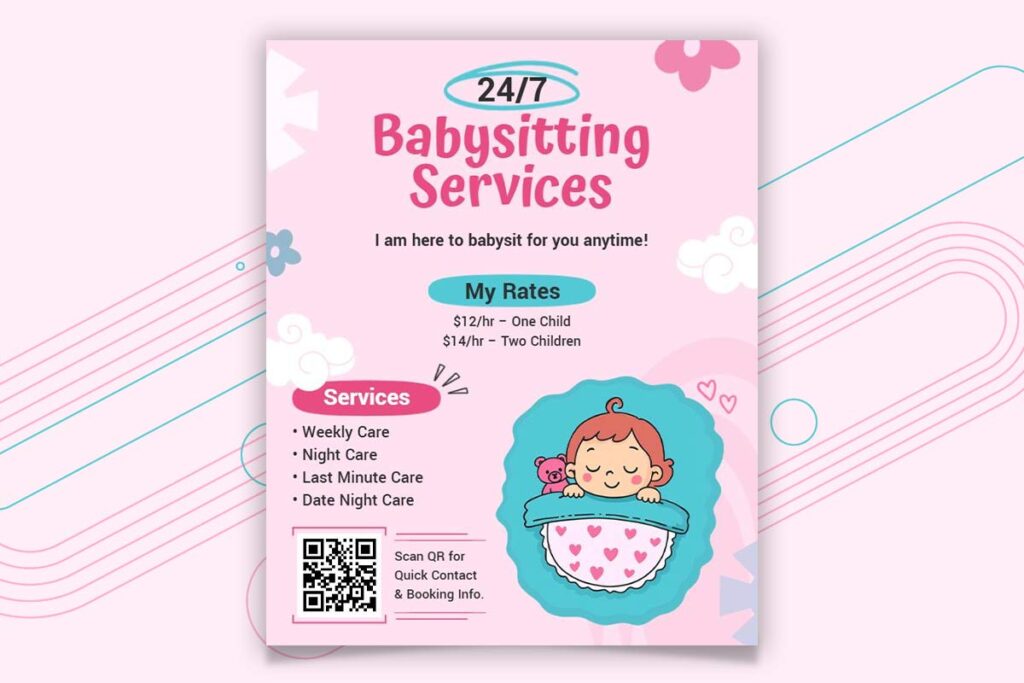Premium babysitting services can stand out from basic providers and justify higher rates by using credibility flyers that highlight their qualifications, safety training, specialized expertise, and experience. These flyers go beyond listing availability, instead building trust through certifications, client testimonials, and detailed service portfolios, positioning providers as professional childcare experts rather than casual sitters.
Effective flyer-based credibility combines certification showcases with strategic pricing communication and professional design elements. Premium providers must highlight CPR certifications, background checks, and specialized skills through certified babysitting flyers that justify elevated rates. Success requires integrating professional portfolios with targeted messaging that addresses parent safety concerns while demonstrating tangible value propositions that separate premium services from basic childcare options. Use a professional flyer maker to create custom, eye-catching babysitting flyers that communicate credibility and premium value.
How Do Babysitting Credibility Flyers Help Premium Providers Justify Higher Rates?
Babysitting credibility flyers enable premium providers to command higher rates by visually showcasing their professional qualifications, specialized training, and extensive experience. These certified babysitting flyers highlight credentials like CPR certification, early childhood education backgrounds, and years of specialized childcare experience. By presenting testimonials, safety protocols, and unique service offerings through professional babysitting flyers, providers demonstrate tangible value that distinguishes them from basic competitors. Parents readily pay premium rates when they see documented expertise, making credibility flyers essential positioning tools for establishing trust and justifying elevated pricing in competitive childcare markets.
Showcasing Professional Certifications and Specialized Training Through Babysitting Experience Flyers
Professional certifications form the foundation of premium rate justification in babysitting credibility flyers. CPR and First Aid certifications from recognized organizations like American Red Cross immediately establish safety competence that basic providers lack. Early childhood development courses, SafeSitter training, and specialized certifications for autism support or newborn care demonstrate advanced expertise.
Babysitting experience flyers featuring these credentials create visual proof of professional investment. Parents understand that certified providers have invested time and money in specialized training, justifying rates 40-60% higher than uncertified competitors. Background check completions, ongoing education certificates, and liability insurance coverage further reinforce premium positioning. The strategic placement of certification badges and training documentation transforms simple service advertisements into professional portfolios that command respect and premium compensation.
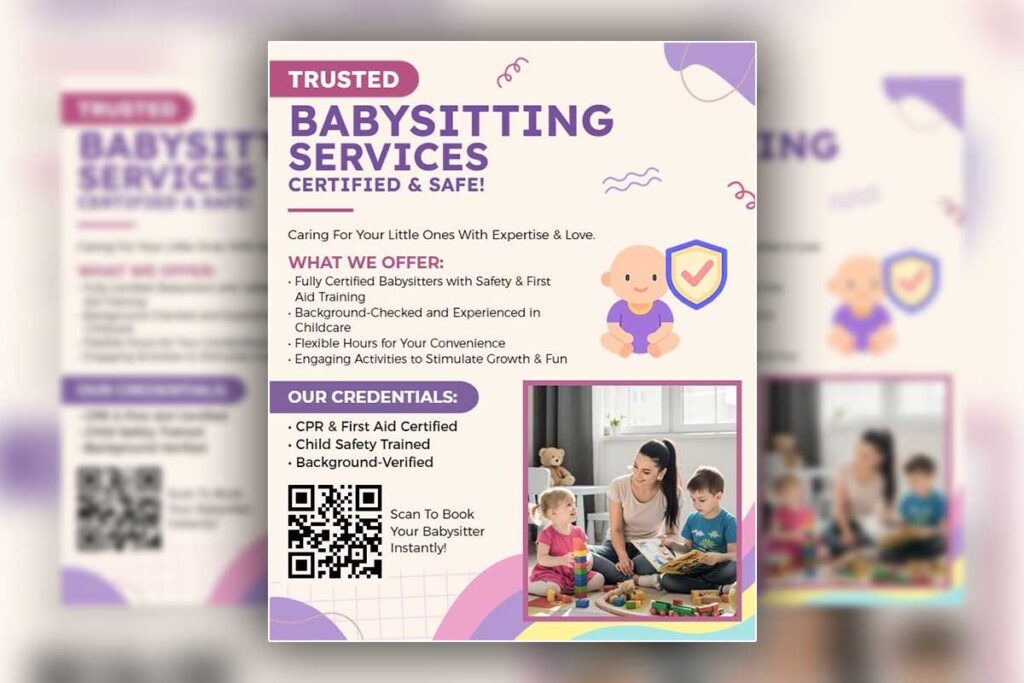
Using Client Testimonials and Success Stories to Support Premium Pricing Strategies
Client testimonials provide social proof that validates premium pricing decisions for discerning parents. Trusted babysitting flyers featuring specific testimonials from satisfied families demonstrate proven track records with real results. Parents sharing experiences about emergency situations handled professionally, children’s developmental progress under specialized care, or successful management of multiple children create compelling justification for higher rates.
Effective testimonials focus on unique value propositions rather than generic satisfaction statements. References highlighting specialized skills like homework assistance, meal preparation expertise, or successful behavior management with challenging children establish premium service differentiation. Including parent contact information where permitted adds authenticity that basic advertisements cannot match. These success stories transform pricing discussions from cost comparisons into value assessments, allowing premium providers to justify rates based on demonstrated outcomes and specialized capabilities.
- Affordable Babysitting and Childcare Service Flyer Template
- Affordable Babysitting Services Flyer Template
- Affordable Babysitting Service Promotion Flyer Template
- Trusted Babysitting Services Promotional Flyer Template
Highlighting Unique Service Differentiators That Command Higher Babysitting Rates
Premium babysitting rates require clear service differentiation beyond basic supervision. Babysitting qualifications flyers should emphasize unique offerings like educational enrichment activities, specialized meal preparation, or advanced safety protocols.1 Providers offering tutoring services, language immersion, or developmental milestone tracking justify premium positioning through comprehensive childcare approaches.
Multi-child management expertise, overnight care capabilities, and special event supervision represent advanced service levels warranting higher compensation. Emergency preparedness beyond basic first aid, including allergy management protocols and specialized equipment familiarity, positions providers as childcare professionals rather than casual sitters.
Insurance coverage, bonded status, and professional references from pediatricians or childcare facilities further establish institutional credibility. These differentiators create clear value propositions that justify premium rates while addressing parents’ top concerns about child safety, development, and wellbeing. The right flyer design can help communicate these qualities effectively, such as the trustworthy babysitting service flyer template that transforms babysitting from a commodity service into a professional childcare investment.
What Makes Babysitting Credibility Flyers More Effective Than Basic Advertisements?
Babysitting credibility flyers outperform basic advertisements by providing comprehensive credential documentation rather than simple service listings. While basic ads mention availability and rates, trusted babysitting flyers showcase specific qualifications, safety certifications, and detailed experience portfolios. These babysitting qualifications flyers build immediate trust through visual proof of expertise, including photos of training certificates, client references, and specialized skills. The structured format allows parents to quickly assess provider credibility, unlike basic advertisements that lack substance. This credibility-focused approach converts prospects more effectively by addressing parents’ primary concern: their children’s safety and wellbeing.
Building Immediate Trust Through Comprehensive Credential Documentation
Professional babysitting flyers establish instant credibility through systematic credential displays that basic advertisements cannot match. These flyers prominently feature CPR certifications, first aid training, and background check completions with visible dates and issuing organizations. Parents see tangible proof of qualifications rather than empty claims about reliability.
Certified babysitting flyers include education backgrounds, specialized training certificates, and relevant experience details that demonstrate professional commitment. This comprehensive documentation approach transforms parent skepticism into confidence because credentials provide verifiable evidence of competency.
Basic advertisements typically list generic qualifications like “experienced” or “responsible” without supporting evidence. Professional babysitting flyers counter this weakness by displaying actual certification photos, training completion certificates, and professional development records. Parents can verify credentials independently, creating trust that generic advertisements cannot establish. This thorough documentation approach justifies premium rates while demonstrating the provider’s professional approach to childcare services.
Converting Parent Prospects with Visual Proof of Babysitting Expertise
Visual proof elements in babysitting credibility flyers convert hesitant parents through concrete evidence of expertise and reliability. Professional photographs showing providers engaged with children during supervised activities demonstrate practical experience beyond written descriptions.
Testimonial sections with parent photos and specific feedback create authentic social proof that basic advertisements lack. These trusted babysitting flyers include detailed references with contact information, allowing verification of provider claims. Visual elements like certification badges, training photos, and professional headshots establish credibility through multiple proof points.
Parents respond positively to structured presentations that organize information clearly. Professional babysitting flyers use consistent formatting, quality typography, and strategic white space to convey reliability. This visual sophistication signals professional standards that justify higher rates. Basic advertisements appear amateur by comparison, using generic layouts and minimal visual elements that fail to inspire confidence in discerning parents seeking quality childcare. Read more in our guide on babysitting lead generation flyers for new babysitters.
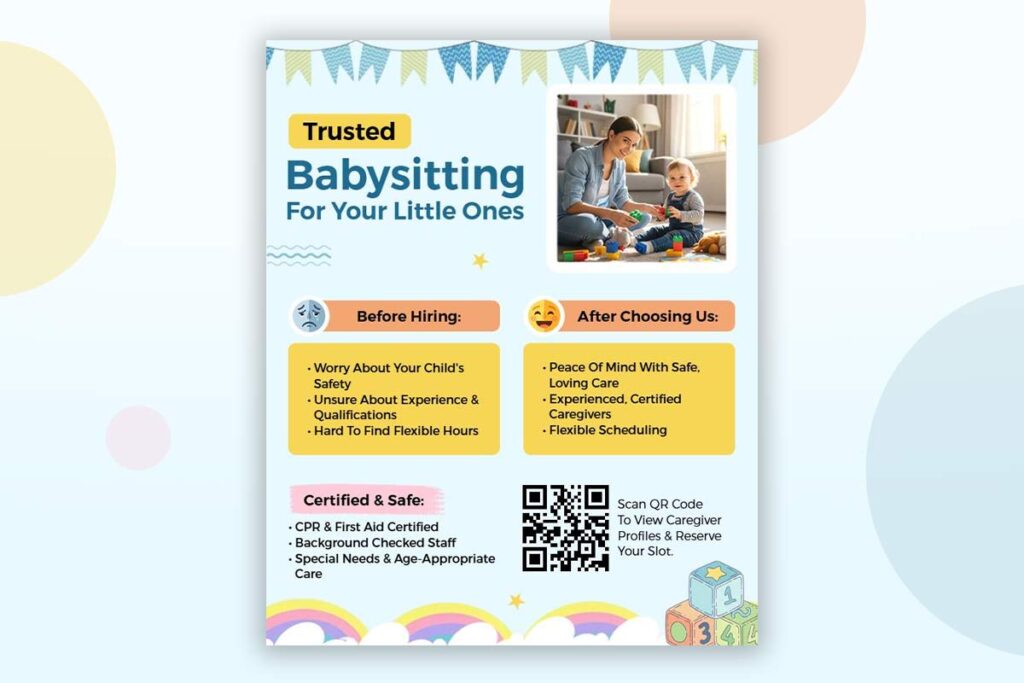
Addressing Safety Concerns That Basic Advertisements Cannot Tackle
Safety concerns represent parents’ deepest anxiety when selecting childcare providers, making comprehensive safety credential display essential for conversion success. Babysitting experience flyers address these concerns through dedicated safety protocol sections that basic advertisements completely ignore.
Professional flyers showcase emergency response training with specific certification details, including pediatric CPR, allergy management, and injury response protocols. Parents see concrete evidence of safety preparedness through displayed certificates and training documentation. This transparency builds confidence that providers can handle emergency situations competently.
Insurance coverage information provides additional safety assurance that basic advertisements never mention. Professional babysitting flyers include liability insurance details, bonding information, and comprehensive background check results with completion dates. Parents appreciate this transparency because it demonstrates professional accountability and financial protection.
Communication protocols outlined in professional flyers establish clear safety expectations. These include check-in procedures, emergency contact systems, and detailed instructions for various scenarios. Parents gain peace of mind knowing providers follow structured safety approaches rather than improvised responses.
Basic advertisements fail to address safety concerns systematically, leaving parents uncertain about provider preparedness. Professional credibility flyers eliminate this uncertainty through comprehensive safety credential documentation, converting anxious parents into confident clients willing to pay premium rates for demonstrated expertise and reliability.
Which Certifications Should Premium Babysitting Credibility Flyers Highlight Prominently?
Premium babysitting credibility flyers should prominently feature CPR/First Aid certifications, child development credentials, and specialized training certificates. Essential certifications include American Red Cross CPR, pediatric first aid, and childcare development associate (CDA) credentials. Professional babysitting flyers gain credibility through displaying SafeSitter certifications, background check completions, and specialized program training like autism support or newborn care. These certified babysitting flyers should also highlight continuing education certificates, age-specific training credentials, and any relevant college coursework in child development, psychology, or education to justify premium rates.
Life-Safety Certifications That Build Parent Confidence
CPR and First Aid certifications form the foundation of trusted babysitting flyers. The American Red Cross CPR certification demonstrates competency in infant, child, and adult resuscitation techniques. Pediatric First Aid certification shows preparation for common childhood injuries and medical emergencies. These life-safety credentials address parents’ primary concern about leaving children with caregivers.
SafeSitter certification combines basic childcare skills with safety training, covering injury prevention, emergency response, and basic childcare techniques. This comprehensive program certification signals professional preparation beyond casual babysitting. Babysitting qualifications flyers should display certification logos prominently in the header section with expiration dates to demonstrate current training status.
Additional safety certifications include water safety training for pool supervision, allergy management training for children with food sensitivities, and basic medical training for administering prescribed medications. Each certification should include the issuing organization name and completion date to build credibility through specific, verifiable credentials that differentiate premium providers from basic competitors. The American Heart Association emphasizes that their “evidence-based resuscitation education” helps improve “learning, skill mastery and skill retention” for childcare professionals.2
Child Development and Behavioral Training Credentials
Child Development Associate (CDA) credentials establish professional expertise in early childhood education and development. This nationally recognized certification demonstrates formal training in child psychology, developmental milestones, and age-appropriate activities. Professional babysitting flyers featuring CDA credentials justify premium rates through educational expertise.
Early childhood education coursework from accredited institutions, even without degree completion, adds credibility to babysitting experience flyers. Behavioral management training certificates show preparation for challenging situations like tantrums, sibling conflicts, and homework resistance. These credentials appeal to parents seeking educational support alongside supervision.
Specialized training in areas like positive discipline techniques, homework assistance methods, and creative activity planning positions providers as educational partners rather than basic supervisors. Montessori training, play therapy workshops, and child psychology courses demonstrate commitment to child development expertise. Certified babysitting flyers should present these qualifications in a dedicated “Education & Training” section, making it easy for parents to see the provider’s professional dedication to supporting both safety and learning.
Specialized Care Certifications for Premium Positioning
Special needs training certifications command premium rates by addressing specialized childcare markets. Autism spectrum disorder training, sensory processing support certification, and developmental delay experience demonstrate capability with children requiring additional support. These specialized credentials allow premium providers to serve families with specific needs while justifying higher rates.
Language proficiency certifications appeal to multilingual families seeking cultural connection and language preservation. Bilingual childcare training or foreign language fluency certificates expand service appeal and justify premium positioning. Music therapy training, art instruction certification, and sports coaching credentials offer enrichment services beyond basic supervision.
Newborn care certification addresses infant-specific needs including feeding techniques, sleep safety protocols, and developmental stimulation. This specialized training serves families with babies requiring experienced caregivers comfortable with infant care complexities.
Technology safety training and digital wellness certification address modern parenting concerns about screen time and online safety. Pet care certification appeals to families with animals requiring care during babysitting sessions. Each specialized certification should include training duration, skills covered, and practical applications to demonstrate comprehensive preparation for premium childcare services that extend beyond basic supervision into educational and developmental support.
- Babysitting Certification Course Flyer Template
- Babysitting Service Contact Information Flyer Template
- Babysitter Training Course Flyer Template
How Can Babysitting Credibility Flyers Showcase Professional Experience Effectively?
Babysitting credibility flyers showcase professional experience effectively through quantified achievements, strategic testimonial placement, and specific scenario examples that demonstrate competency beyond basic supervision. Professional babysitting flyers convert prospects by highlighting measurable results like years of service, families served, and specialized situations managed successfully. Trusted babysitting flyers incorporate client feedback strategically positioned alongside experience metrics, while certified babysitting flyers emphasize credentials that validate practical expertise. Effective experience presentation connects past achievements to current capabilities, showing parents exactly why premium rates reflect superior value through documented professional track record.
Quantifying Experience Through Measurable Achievements
Transform vague experience claims into compelling statistics that parents can evaluate objectively. List specific numbers: “5+ years childcare experience,” “150+ families served,” or “500+ hours overnight care completed.” Include age range expertise like “Experience with newborns through teenagers” to demonstrate versatility. Highlight specialized counts such as “Managed 50+ birthday parties” or “Provided emergency care in 12 situations.” These metrics differentiate professional providers from casual sitters who cannot quantify their background.
Professional babysitting flyers gain credibility when experience sections include employment history, volunteer work with children, and relevant training programs completed. Specify challenging scenarios successfully handled: “Supervised 4 children simultaneously during family emergency” or “Managed diabetic child’s care routine for 2 years.” Parents respond positively to concrete evidence of capability rather than generic “experienced with kids” statements that provide no meaningful differentiation from competitors.
Strategic Testimonial Integration for Maximum Impact
Position client testimonials strategically throughout experience sections to reinforce quantified achievements with authentic parent feedback. Select quotes that highlight specific professional qualities: reliability during emergencies, educational engagement, or exceptional communication. Include parent names and relationship context when possible: “Sarah M., parent of twin toddlers” adds credibility over anonymous reviews.
Babysitting qualifications flyers perform better when testimonials address common parent concerns directly. Choose feedback mentioning safety consciousness, trustworthiness, and professional boundaries. Avoid generic praise; select comments that highlight unique capabilities like “Emma helped our daughter with homework while managing bedtime routines for our toddler” or “Handled our son’s asthma attack calmly while keeping other children engaged.”
Format testimonials with clear attribution and specific situations to maximize authenticity and relatability for prospective clients.
Demonstrating Expertise Through Real-World Scenario Examples
Present brief case studies that illustrate problem-solving abilities and professional judgment in realistic childcare situations. Describe specific challenges overcome: managing multiple children during birthday parties, handling bedtime resistance with consistent routines, or coordinating activities during rainy day indoor play. These scenarios demonstrate competency beyond basic supervision while showing parents exactly what professional experience delivers.
Babysitting experience flyers should include examples of educational activities implemented, behavioral challenges addressed, and safety protocols followed. Mention specific skills applied: “Implemented structured homework time for three school-age children while supervising toddler play” or “Created engaging educational games during 8-hour care periods.” These examples show proactive engagement rather than passive watching.
Professional scenarios demonstrate expertise with special situations: caring for children with allergies, managing technology limits, or coordinating pickup schedules for multiple activities. Include examples of parent communication: regular updates during long care periods or detailed reports about children’s activities and behavior. These specifics show systematic professional approach that justifies premium rates.
Effective experience presentation transforms babysitting credibility flyers from simple advertisements into compelling professional portfolios that build parent confidence and justify premium positioning through documented expertise and proven track record.
What Design Elements Make Babysitting Credibility Flyers Appear More Trustworthy?
Trustworthy babysitting credibility flyers rely on professional design elements that immediately convey reliability and competence to concerned parents. Clean typography, strategic color choices, and proper credential placement establish credibility before parents read a single word. Professional photography combined with consistent visual hierarchy creates the polished appearance that justifies premium rates and distinguishes certified babysitters from casual providers.
Professional Photography Standards That Build Parent Confidence
High-quality headshots demonstrate professionalism while building immediate trust with skeptical parents. Professional babysitting flyers require clear, well-lit photos showing genuine expressions rather than casual selfies or grainy phone images. The ideal babysitter photo features professional lighting, appropriate childcare attire, and a warm yet competent expression that reassures parents about their children’s safety.
Background elements should remain neutral, avoiding distracting patterns or unprofessional settings. Photos must be recent and accurately represent the babysitter’s current appearance to maintain honesty and trust. Including secondary photos showing interaction with children (with proper permissions) strengthens credibility by demonstrating actual childcare experience.
Certified babysitting flyers benefit from consistent photo sizing and professional editing that maintains natural appearance while eliminating technical flaws. This visual investment signals serious commitment to childcare professionalism, justifying higher rates compared to providers using amateur photography.
- Charming Soft Pink Childcare Services Information Flyer Template
- Cheerful Baby Sitting Services with Blue Balloons Flyer Template
- Colorful Babysitting Service Promotion Flyer Template
Typography and Color Psychology for Childcare Trust Building
Typography choices directly impact parent perception of babysitter reliability and professionalism. Clean, readable fonts like Arial or Helvetica convey trustworthiness, while decorative fonts appear unprofessional and difficult to read. Research emphasizes that “users won’t read web content unless the text is clear, the words and sentences are simple, and the information is easy to understand.”3 Babysitting qualifications flyers perform better with consistent font hierarchy using bold headers, regular body text, and italics for testimonials, as proper typography is essential for ensuring content accessibility and user comprehension.
Color psychology plays crucial roles in establishing trust with parents. Navy blue suggests reliability and competence, while soft greens convey safety and calm nurturing qualities. These colors work better than bright reds or oranges, which can appear unprofessional or overstimulating for childcare contexts.
Trusted babysitting flyers maintain consistent color schemes throughout, using maximum three complementary colors to avoid visual chaos. White space enhances readability while creating clean, organized appearance that parents associate with professional childcare providers. Color consistency across all marketing materials reinforces brand recognition and professional credibility.
Strategic Placement of Certification Badges and Credentials
Certification badges require prominent placement in the upper portion of babysitting credibility flyers where parents immediately notice professional qualifications. CPR and First Aid certifications should appear near the babysitter’s name and contact information, creating immediate credibility before parents read detailed content.
Visual hierarchy ensures most important credentials receive prime positioning. Life-safety certifications like CPR belong at the top, followed by childcare training certificates, then background check verification. Each badge needs sufficient white space to maintain visual impact without creating cluttered appearance that dilutes individual credential importance.
Professional babysitting flyers organize credentials using consistent badge sizing and alignment. Certification logos should be official versions downloaded from issuing organizations, not recreated graphics that appear unprofessional. Include certification dates and renewal information to demonstrate current validity.
Organizing credentials into distinct sections such as safety certifications, educational credentials, and specialized training makes it easy for parents to find what matters most to them. Providers who want inspiration for layout, color choices, and effective visual balance can create a flyer using babysitting flyer design tips for creative specialists that highlight credentials with maximum impact.
How Do Premium Babysitting Credibility Flyers Address Skeptical Parent Concerns?
Premium babysitting credibility flyers proactively address parent skepticism by prominently featuring background check certifications, detailed safety training credentials, and comprehensive insurance coverage information. They include specific testimonials with full parent names and neighborhoods, emergency response qualifications, and transparent pricing structures. Advanced flyers showcase specialized training like CPR certification, first aid expertise, and child development education. By addressing common concerns upfront through dedicated sections for safety protocols, communication methods, and professional references, these flyers eliminate doubt before parents can raise objections, positioning the service as thoroughly vetted and premium-worthy.
Background Check Transparency and Safety Credential Display
Professional babysitting credibility flyers combat trust barriers by prominently displaying background check completion dates and verification numbers. Include specific safety certifications with expiration dates, such as “CPR Certified through American Red Cross – Valid until 2025” and “Background Check Completed – Case #BC2024-789.” Visual elements like certification badges and official logos create immediate credibility. Display specialized training certificates including SafeSitter certification, pediatric first aid, and childcare development credentials. Professional babysitting flyers benefit from clear documentation sections that show continuous education commitments. Present qualification information using consistent formatting that emphasizes official verification rather than self-reported claims. Trusted babysitting flyers should include regulatory compliance indicators and professional association memberships that demonstrate ongoing accountability to established childcare standards.
- Charming Soft Pink Childcare Services Information Flyer Template
- Bold Blue Heartwarming Babysitting Service Flyer Template
- Playful Pink Babysitting Services Advertisement Flyer Template
- Tropical Blue and Mint Tulip Baby Flyers Template
Parent Testimonial Authentication and Reference Verification
Skeptical parents require verifiable testimonials rather than anonymous reviews. Premium certified babysitting flyers include full parent names, neighborhoods, and specific service dates like “Sarah Johnson, Maple Heights – June 2023 to Present.” Testimonials address specific concerns: emergency handling, communication quality, and child engagement. “When Emma had an allergic reaction, Jessica remained calm and followed our emergency plan perfectly” provides concrete evidence of competency. Reference sections include phone numbers or email addresses when permitted, allowing verification of service quality. Professional babysitting experience flyers organize testimonials by service type – overnight care, special needs support, multiple children supervision. Authentic testimonials mention specific situations handled professionally, creating confidence in the provider’s proven track record with real families facing actual childcare challenges.
Emergency Preparedness and Insurance Coverage Communication
Parents fear worst-case scenarios, making emergency preparedness crucial for premium positioning. Babysitting qualifications flyers detail specific emergency protocols: “Certified in infant CPR, maintains updated allergy action plans, carries emergency contact cards.” Include liability insurance coverage amounts and provider information to address financial protection concerns. Professional flyers outline communication procedures during emergencies, including hospital preferences and medication administration protocols. Address technology concerns by specifying phone accessibility and emergency contact methods. Advanced providers highlight specialized equipment access like EpiPens, inhalers, or glucose monitors for children with medical needs. Include proximity to medical facilities and transportation arrangements for emergency situations. Premium babysitting credibility flyers demonstrate comprehensive risk management through detailed preparation rather than generic safety promises, creating confidence in professional emergency response capabilities.
What Reference Format Works Best In Babysitting Credibility Flyers For Professionals?
Professional babysitting credibility flyers perform best with structured reference formats that include full contact details, relationship context, and specific testimonials. The most effective approach combines parent contact information with detailed feedback about childcare skills, reliability, and special situations handled. Premium Experienced Babysitting Service Template providers should display 3-4 references using consistent formatting that includes parent names, contact methods, duration of service, and brief testimonials highlighting expertise. This format allows potential clients to verify credentials while showcasing proven track records. Professional babysitting flyers benefit from reference sections that emphasize specialized skills and successful childcare outcomes rather than generic recommendations.
Contact Information Architecture for Parent References
Structure reference contact details using consistent formatting that builds immediate credibility. Include full parent names with titles when appropriate, such as “Dr. Sarah Johnson” or “Jennifer Smith, RN,” which adds professional weight to testimonials. Display complete contact information including phone numbers and email addresses when parents provide permission, as this transparency demonstrates confidence in service quality. Format addresses by neighborhood or general area rather than full street addresses for privacy protection while maintaining location verification.
Organize contact information in professional blocks that separate each reference clearly. Use consistent typography with parent names in bold, followed by contact methods and relationship context. Include service dates prominently to show recent and ongoing relationships. This architecture allows potential clients to easily contact references while presenting information in a scannable format that builds trust through transparency.
Testimonial Integration Within Reference Displays
Integrate specific testimonials directly beneath each reference’s contact information using quotation marks and clear attribution. Focus on testimonials that highlight professional qualities like punctuality, emergency handling, and specialized care rather than generic praise. Include specific examples such as “Sarah expertly managed my son’s food allergies during overnight care” or “Handled bedtime routine for three children under five with remarkable patience.”
Format testimonials using indented text or distinctive styling to separate them from contact information. Keep quotes concise but specific, typically 20-30 words that capture concrete achievements or professional behaviors. Include context about children’s ages and special circumstances when relevant, as this demonstrates experience with diverse childcare challenges. Position the strongest testimonial first to create immediate positive impact.
Duration and Context Formatting for Service History
Present service duration using clear date ranges that demonstrate consistency and reliability. Format as “June 2023 – Present” or “September 2022 – August 2023” to show specific timeframes rather than vague terms like “recently.” Include frequency information such as “weekly date nights” or “summer vacation care” to provide context about service intensity and trust level built with families.
Add context details that showcase professional expertise through specific situations handled. Include information like “overnight care for twin infants,” “managed pickup from three different schools,” or “provided care during parent business travel.” This context demonstrates capability beyond basic supervision while showing the trust parents place in professional services.
Structure the complete reference format as a cohesive unit with contact information at the top, service duration in the middle, and testimonials at the bottom. Use consistent spacing and typography throughout all references to maintain professional appearance. This systematic approach allows parents to quickly assess credibility while providing multiple ways to verify professional qualifications and service quality through direct parent contact.
How Should Babysitting Credibility Flyers Display Specialized Childcare Skills?
Specialized childcare skills on babysitting credibility flyers require strategic visual hierarchy and specific competency categorization. Premium providers should organize skills into distinct sections such as age-specific expertise, medical care capabilities, educational support, and behavioral management techniques. Certified babysitting flyers perform better when skills are presented with supporting credentials, training certificates, and real-world application examples. The most effective approach combines skill listings with brief descriptions of how these abilities benefit families. Trusted babysitting flyers should prioritize skills that differentiate premium services from basic childcare, emphasizing advanced capabilities like special needs support, homework assistance, and emergency response training.
Age-Specific Expertise Categorization Methods
Professional babysitting flyer Template gain credibility through clear age-group specialization display. Create distinct sections for infant care (0-12 months), toddler management (1-3 years), school-age supervision (4-12 years), and teen mentoring (13+ years). Each category should highlight specific skills like diaper changing protocols, potty training support, homework assistance methods, or conflict resolution techniques. Babysitting experience flyers benefit from displaying years of experience within each age range, number of children supervised simultaneously, and relevant training for developmental stages.
Highlight age-specific experience and specialized training like infant CPR or toddler behavior management to show expertise beyond basic babysitting and reinforce premium credibility.
- Professional Babysitting Services Offer Flyer Template
- Comprehensive Babysitting Services Flyer Template
- Reliable Babysitting Services Advertisement A4 Flyer Template
Medical and Safety Skill Documentation Standards
Babysitting qualifications flyers must prominently feature life-safety certifications and medical care capabilities. Display CPR and First Aid certifications with renewal dates, pediatric emergency response training, and allergy management protocols. Include specific medical skills like medication administration, emergency contact procedures, and basic injury assessment techniques. Safety documentation should cover home safety protocols, outdoor supervision standards, and emergency evacuation procedures.
Present medical skills with concrete examples rather than generic listings. Instead of “first aid certified,” specify “trained in choking response for all ages, wound care, and emergency assessment.” Include any specialized medical training like seizure management, diabetes care, or asthma response protocols. This detailed approach demonstrates comprehensive preparation that justifies premium rates and builds parent confidence in emergency situations.
Educational and Developmental Support Presentation
Educational capabilities distinguish premium babysitting credibility flyers from basic supervision services. Highlight tutoring abilities by subject area, homework assistance methods, creative activity leadership, and developmental milestone support. Include specific educational backgrounds, relevant coursework, and specialized training in child development or early childhood education. Present these skills with examples of successful educational outcomes or creative programs implemented.
Behavioral management skills require detailed presentation including positive reinforcement techniques, conflict resolution methods, and age-appropriate discipline strategies.4 Showcase experience with challenging behaviors, special needs support, and individualized attention strategies. Include any training in autism support, ADHD management, or emotional regulation techniques that demonstrate advanced childcare capabilities.
Language skills, technology proficiency, and creative abilities add premium value. Display multilingual capabilities, educational app familiarity, arts and crafts expertise, or musical instruction abilities. These additional skills justify higher rates by offering enrichment opportunities beyond standard supervision. Present them as value-added services that enhance children’s development during childcare hours.
What Pricing Strategy Should Babysitting Credibility Flyers Communicate For Premium Services?
Premium babysitting credibility flyers should communicate value-based pricing through specialized certifications, advanced qualifications, and unique service offerings. Highlight CPR certification, early childhood education credentials, and specialized skills like tutoring or special needs care. Present pricing as investment in child safety and development rather than hourly rates. Include testimonials emphasizing peace of mind and educational benefits. Structure pricing tiers around service levels – basic supervision, educational enrichment, and comprehensive care packages. Avoid competing on lowest price; instead, position premium rates as reflection of professional expertise, reliability, and enhanced child outcomes that justify higher investment.
Certification-Based Rate Justification Strategies
Professional babysitting credibility flyers justify higher rates by prominently displaying certifications like CPR/First Aid, specialized training credentials, and educational backgrounds. Position certifications as direct value propositions parents pay for peace of mind knowing their provider can handle emergencies. Display training certificates visually with dates and renewal information to demonstrate ongoing professional development. According to industry data, providers with visible certifications command 30–40% higher rates than uncertified competitors. Link specific qualifications to pricing premiums: basic certified babysitter rates, specialized care premiums for special needs experience, and premium rates for overnight or emergency services. Providers can use flyer templates to make these qualifications highly visible, creating clear connections between professional expertise and service reliability that justify elevated pricing structures.
Value-Tier Service Package Presentation
Effective babysitting credibility flyers structure pricing through tiered service packages that demonstrate increasing value propositions. Basic tier includes standard supervision and emergency preparedness, mid-tier adds educational support and activity planning, premium tier provides comprehensive developmental monitoring and specialized care capabilities. According to, tiered presentation helps parents understand value differences rather than comparing hourly rates alone. Present packages as investment levels in child development rather than simple time-based costs. Include specific deliverables for each tier – basic safety protocols, educational enrichment activities, detailed daily reports, or specialized behavioral support. This approach positions premium services as comprehensive childcare solutions rather than expensive babysitting alternatives.
Premium Positioning Through Specialized Skill Premiums
Specialized childcare skills justify premium pricing when presented as unique value propositions that address specific parent needs and concerns. Highlight advanced capabilities like special needs support, multiple language fluency, homework assistance, or infant care expertise as service differentiators worth premium rates. Create skill-specific pricing structures that demonstrate specialized training value – tutoring backgrounds command educational premiums, medical training justifies health-related surcharges, and behavioral management experience warrants specialized care rates. Present specialized skills with supporting credentials and real-world application examples that show tangible benefits for families. Include testimonials from families who benefited from specialized services to reinforce value propositions. Position premium rates as investments in children’s development, safety, and educational advancement rather than luxury services. Create clear connections between specialized training, unique capabilities, and enhanced outcomes that justify higher investment compared to basic supervision services.
How Can Babysitting Credibility Flyers Differentiate From Basic Childcare Advertisements?
Babysitting credibility flyers differentiate from basic advertisements by showcasing comprehensive professional qualifications rather than simple availability and rates. While basic ads mention contact details and hourly fees, professional babysitting flyers display certifications, specialized training, detailed experience portfolios, and safety protocols. These credibility flyers build immediate trust through visual proof of expertise including training certificates, client testimonials, background check verification, and specialized skills documentation. The structured format allows parents to quickly assess provider qualifications and safety preparedness, unlike basic advertisements that lack substance and fail to address parents’ primary concerns about child safety and professional competence.
Professional Portfolio Integration Versus Basic Contact Information
Professional babysitting credibility flyers integrate comprehensive portfolios showcasing years of experience, number of families served, and specialized training achievements. These flyers feature detailed credential sections displaying CPR certifications, early childhood education backgrounds, and specialized program completions with renewal dates. Unlike basic advertisements listing only names and phone numbers, credibility flyers include professional headshots, references with full contact details, and testimonials highlighting specific expertise like special needs care or emergency handling. The portfolio approach demonstrates commitment to professional childcare standards while basic ads convey casual, unreliable service. This comprehensive presentation justifies premium rates by visually documenting the provider’s investment in professional development and specialized skills that distinguish them from basic supervisory services.
Specialized Service Showcase Beyond Standard Supervision
Trusted babysitting flyers prominently display specialized services that extend far beyond basic supervision, including homework assistance, activity planning, developmental milestone tracking, and educational enrichment programs. These flyers detail capabilities like multiple language fluency, special needs support, newborn care expertise, and behavioral management techniques that justify premium positioning. Professional providers showcase unique offerings such as structured learning activities, outdoor adventure planning, or therapeutic play sessions that basic advertisers cannot provide. The specialized service presentation demonstrates professional childcare philosophy focused on child development rather than mere supervision, clearly differentiating premium providers from basic sitters who offer only safety monitoring and entertainment.
- Reliable Babysitting Service Tear-Off Flyer Template
- Babysitter Service Availability Flyer Template
- Trusted Babysitting Services Promotional Flyer Template
- Babysitting Service Offerings Flyer Template
Advanced Safety Protocol Communication and Emergency Preparedness Display
Premium babysitting credibility flyers emphasize a provider’s advanced preparedness by showcasing verified safety protocols, emergency response procedures, and medical training certifications. They often include background check verification badges, proof of insurance coverage, and detailed emergency action plans for scenarios ranging from minor injuries to serious medical situations. These materials also highlight specialized training such as pediatric first aid, allergy management, and autism support techniques, demonstrating the caregiver’s ability to handle diverse needs with confidence. By featuring evidence like certification photos, training completion documents, and comprehensive safety checklists, these flyers go far beyond simply stating a provider is “responsible” or “safe.” Instead, they offer parents concrete reassurance that their children will be cared for by a thoroughly vetted professional with the expertise, equipment familiarity, and developmental knowledge needed to ensure safety and well-being at all times.
People Also Ask: Flyer-based Credibility And Expertise Demonstration Implementation Questions
- How do babysitting credibility flyers build parent trust?
Babysitting credibility flyers build trust through prominent certification displays, professional references, background check verification, and detailed experience descriptions. Include insurance coverage, emergency protocols, and contact information to demonstrate comprehensive preparation
and accountability. - What certifications should babysitting credibility flyers highlight?
Highlight CPR/First Aid certifications, childhood development training, safety courses, and specialized needs experience. Display certification logos with dates and include background check completion and liability insurance coverage for maximum credibility impact. - How can babysitting credibility flyers justify premium rates?
Justify premium rates by showcasing professional qualifications, specialized training, extensive experience, and comprehensive insurance coverage. Connect higher rates to superior value through detailed credential presentations and testimonials emphasizing reliability and expertise. - What design makes babysitting credibility flyers most professional?
Professional designs use clean layouts, consistent fonts, trust-building colors, and quality printing. Include professional headshots, organized information sections, and avoid cluttered or childish graphics that undermine credibility and premium positioning. - How should references appear on babysitting credibility flyers?
Format references with full names, relationships, and specific testimonials highlighting professional qualities. Include contact information when permitted and focus quotes on reliability, specialized care, and professionalism rather than generic praise. - What experience details strengthen babysitting credibility flyers?
Include specific years of experience, number of families served, age ranges handled, and relevant qualifications. Quantify achievements with concrete numbers and highlight specialized experience like special needs care or overnight services.
FAQs: Flyer-based credibility and expertise demonstration Implementation
- How do professional babysitting credibility flyers justify premium rates?
Premium babysitting credibility flyers justify higher rates by showcasing CPR/First Aid certifications, specialized training, extensive experience, client testimonials, background checks, and insurance coverage, while presenting pricing confidently with clear value propositions that explain why premium services merit a higher investment than basic providers. - What certifications make babysitting credibility flyers most trustworthy?
Include CPR/First Aid certifications, safety training, childhood development courses, specialized needs experience, background checks, and liability insurance on babysitting flyers, highlighting logos and renewal dates to showcase professional credibility. - How should premium providers format references on babysitting credibility flyers?
List 3–4 references with full names, relationships (e.g., Parent of Emma, 5), and specific testimonials emphasizing reliability, professionalism, and specialized care, including phone numbers or emails when allowed. - What design elements enhance credibility in professional babysitting flyers?
Use a clean, professional layout with consistent fonts, trust-building colors, a professional headshot, clear contact details, and organized sections, avoiding clutter or childish graphics, and print on high-quality paper to reinforce premium service positioning. - How do babysitting credibility flyers address safety concerns effectively?
Showcase safety by including visible certifications, emergency response training, and detailed safety protocols, along with background check verification, insurance information, and emergency contact procedures, emphasizing specialized training like infant CPR, allergy management, or special needs experience. - What experience details strengthen babysitting credibility flyers most?
Highlight years of experience, number of families served, and age ranges handled. Include specific achievements like managing multiple children, special needs experience, or overnight care. Mention relevant education, volunteer work, or professional childcare backgrounds. Quantify experience with specific numbers rather than vague terms to establish concrete credibility. - How should specialized skills appear on babysitting credibility flyers?
Highlight specialized skills like special needs care, multilingual abilities, tutoring, and activity leadership, supported by relevant certifications, to justify premium rates over basic babysitting services. - What pricing communication works best on premium babysitting credibility flyers?
Display rates confidently with a clear structure for base hourly fees, extra charges, and special circumstances, linking pricing to professional qualifications and using ranges for flexibility while maintaining a premium image. - How can babysitting credibility flyers differentiate from basic advertisements?
Use polished layouts, highlight professional credentials, and provide detailed service descriptions with premium positioning language—including insurance, formal training, and structured methods—while featuring testimonials that emphasize reliability and professionalism, positioning your services as comprehensive childcare partnerships rather than basic babysitting. - What contact information builds most trust on babysitting credibility flyers?
Premium babysitting flyers should highlight qualifications, safety training, and experience while including professional contact details, business information, and references to project a trusted, established service.
Conclusion: Flyer-based Credibility And Expertise Demonstration Success Framework
Mastering babysitting credibility flyers transforms premium service providers into trusted childcare professionals who can command higher rates. This framework shows how professional flyers build trust through certification displays, testimonial integration, and skill showcases that directly address parent safety concerns.
Certified babysitting flyers outperform basic ads by providing visual proof of expertise through CPR certifications, background check verification, and detailed experience portfolios. Parents invest in premium rates when they see documented qualifications, specialized training, and emergency preparedness.
Implementation Through Professional Portfolios and Credential Showcases
Providers should feature certification badges, specialized training, and experience metrics in a clean, professional layout. Strategic placement of life-safety certifications, child development training, and specialized care qualifications reinforces value. Quality standards require consistent formatting, professional photography, and clear credential hierarchies.
Optimizing Competitive Positioning
Flyers must balance impressive credentials with warm, approachable presentation. Differentiation comes from specialized skills, emergency response training highlights, and testimonials that elevate services above basic supervision.
Addressing Differentiation Challenges
The framework combines visual credentials with strategic testimonials and skill categorization. Effective flyers address parent concerns with safety protocol sections, insurance coverage displays, and verifiable references. Consistent design, certification prominence, and clear value propositions transform higher rates into justified investments.
This approach ensures babysitting credibility flyers become powerful tools to establish trust, justify premium pricing, and attract clients seeking professional childcare expertise.
Reference:
- American Red Cross. “Babysitting and Advanced Child Care Certification.” Red Cross.
- American Heart Association. “American Heart Association CPR and First Aid.”
- Nielsen Norman Group. “Legibility, Readability, and Comprehension: Making Users Read Your Words.
- National Association for the Education of Young Children. “Developmentally Appropriate Practice in Early Childhood Programs.“
